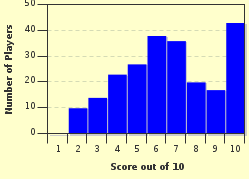Quiz Answer Key and Fun Facts
1. Among the earliest form of clocks were sundial and shadow clocks which relied on the movement of the sun through the sky. Unfortunately these lacked accuracy because, along with other factors, this movement was dependent on the seasons. The Egyptians attempted to improve on accuracy with the use of the clepsydra. What type of timepiece was the clepsydra?
2. An early time measuring device that has survived into the modern era is the hourglass. Modern usage frequently revolves around the boiling of an egg, but what was one of its primary uses in 16th century England?
3. A huge revolutionary step in the clock world came in 1577 with the addition of the minute hand to the clock face. The invention was created by Jost Burgi, at the request of Tycho Brahe. What was Brahe's occupation that made accurate timekeeping so important?
4. The earliest mechanical clocks, based on a verge escapement and foliot balance, were not good on accuracy. Galileo theorised about a new means of providing a constant oscillation that would improve on accuracy. However, it was not until 14 years after his death that Dutch scientist, Christiaan Huygens, built a clock that could demonstrate his theory. What was the revolutionary addition to the mechanism that Huygens introduced?
5. Nowadays the wristwatch is an everyday item worn around the world. However, in the early 17th century it was unheard of. The first man believed to wear a timepiece on his wrist was a mathematician, physicist and philosopher whose contributions to human knowledge included the theory of probabilities, the syringe and an understanding of pressure, whose SI unit is named for him. Who was this sartorial pioneer?
6. Despite the improved accuracy of the clocks devised by the likes of Huygens and Burgi, they all had one significant drawback; they had to be motionless to operate correctly. When it came to the problem of measuring longitude at sea this proved to be problematic. A prize was offered to the man who could come up with a solution to the longitude problem. John Harrison was the horologist who claimed the prize, eventually, with his H4 clock. What type of timepiece was it?
7. Levi Hutchens, an American inventor, created the first mechanical alarm clock in 1787. It had a loud bell that was efficient in rousing a person from sleep but it was far from suitable for use by all due to one particular shortcoming. It would be another 60 years before a patent was issued on an alarm clock that rectified this shortcoming. What was the problem with Hutchens' clock?
8. In 1880, Pierre Curie and his brother Jacques discovered the piezoelectric effect; that when stresses are placed on certain materials, electric potential can be induced. In 1927, Warren Marrison used this knowledge to create a clock that kept time by counting the vibrations of a mineral crystal. What was the mineral that in 1969 was also used to regulate the time of the Seiko Astron, the world's first electronic wristwatch?
9. The principle of the atomic clock was established with the building of an ammonia-based clock in 1949. However, the accuracy of this clock was poor. A much more accurate clock was built in 1955 and named after the chemical element by which its time was measured. Which element, that from 1967 was used to define the SI unit of the second, was it named after?
10. In 1884 the world adopted standardised time based on Greenwich Mean Time (GMT). Though GMT has since been quoted when referring to time around the world, from 1972 it ceased to be the world's official mean time. The Bureau International de l'Heure (BIH) set a new mean time based on the readings from 38 atomic clocks from around the world. What is this new time standard known as?
Source: Author
Snowman
This quiz was reviewed by FunTrivia editor
crisw before going online.
Any errors found in FunTrivia content are routinely corrected through our feedback system.

